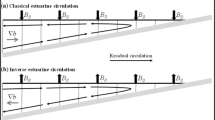Abstract
We numerically investigated the physical process of water exchange caused by fluctuations of the front. This front is formed in a vertically two-dimensional NH-model (non-hydrostatic model) under steady forcing and simulates well the front observed during winter in the Kii Channel, Japan. The velocity field in the model has two kinds of oscillations. The first has a period of 6∼12 hr and is caused by intermittent gravitational convection in the frontal zone. The period and the intensity of intermittent convection are determined by buoyancy flux through the side boundaries as well as surface cooling. The other is associated with large scale circulation driven at the side boundaries and is controlled by the Coriolis force and the bottom stress. Its period of 3∼4 days is determined by the sum of the inertial period and the spin down time for the baroclinic mode of the along-front velocity component. These oscillations make the position of the front fluctuate with the same periods.
We next examined water exchange across the fluctuating front by numerically tracking a number of labelled particles. Intermittent convection induces exchange of particles in the frontal zone and large scale circulations transport the exchanged particles toward offshore or onshore through the lower layer. The exchange rate and the dispersion coefficient are calculated in the NH-model as 0.85 and 2.3×103 cm2 sec−1, respectively. On the other hand, in the H-model (hydrostatic model) parameterizing gravitational convections with a convective adjustment method, these values are reduced to 0.68 and 3.2×102 cm2 sec−1, respectively. This result implies that intermittent convections in the frontal zone have a large effect on water exchange across the front, and that no little water is exchanged across the fluctuating front in an actual shallow sea, such as observed in the Kii Channel.
Similar content being viewed by others
References
Akitomo, K., N. Imasato and T. Awaji (1988a): Numerical model of the generation of a shallow sea front. Proceedings of International Symposium on Physics of Shallow Bays, Estuaries and Continental Shelves, Qingdao, China (in press)
Akitomo, K., N. Imasato and T. Awaji (1988b): A numerical study of a shallow sea front generated by buoyancy flux.—Generation mechanism—. submitted to J. Phys. Oceanogr.
Awaji, T., N. Imasato and H. Kunishi (1980): Tidal exchange through a strait: A numerical experiment using a simple model basin. J. Phys. Oceanogr.,10, 1499–1508.
Endoh, M. (1977): Formation of the thermohaline front by cooling of the sea surface and inflow of the fresh water. J. Oceanogr. Soc. Japan,33, 6–15.
Foster, T.D. (1971): Intermittent convection. Geophys. Fluid Dynam.,2, 201–217.
Gill, A.E. (1982): Atmosphere-Ocean Dynamics. Academic Press, Inc., 662 pp.
Harashima, A. and Y. Oonishi (1981): The Coriolis effect against frontogenesis in steady buoyancy-driven circulation. J. Oceanogr. Soc. Japan,37, 49–59.
Harashima, A., Y. Oonishi and H. Kunishi (1978): Formation of water masses and fronts due to density-induced current system. J. Oceanogr. Soc. Japan,34, 57–66.
Oonishi, Y., A. Harashima and H. Kunishi (1978): The characteristics of a front formed by cooling of the sea surface and inflow of the fresh water. J. Oceanogr. Soc. Japan,34, 17–23.
Sparrow, E.M., R.B. Husar and R.J. Goldstein (1970): Observation and other characteristics of thermals. J. Fluid Mech.,41, 793–800.
Shibata, A. (1983): Meander of the Kuroshio along the Edge of Continental Shelf in the East China Sea. Umi to Sora,52, 113–120 (in Japanese).
Sugimoto, T., S. Kimura and H. Nagae (1985): Oceanic structure and its short-period variations near the Kuroshio front in the East China Sea. (I) Results of current measurement by mooring. Autumn Meeting of Oceanogr. Soc. Japan, 17–18 (in Japanese).
Yoshioka, H. (1971): Oceanic front at Kii-Suido in winter (I). Umi to Sora,46, 1–31 (in Japanese).
Yoshioka, H. (1984): Oceanic Front in the Coastal Sea. Bull. Coastal Oceanogr. (Oceanogr. Soc. Japan),21, 110–117 (in Japanese).
Author information
Authors and Affiliations
Rights and permissions
About this article
Cite this article
Akitomo, K. A numerical study of a shallow sea front generated by the buoyancy flux. Journal of the Oceanographical Society of Japan 44, 171–188 (1988). https://doi.org/10.1007/BF02302641
Received:
Revised:
Accepted:
Issue Date:
DOI: https://doi.org/10.1007/BF02302641




